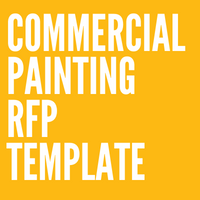
How to develop an RFP (Request for Proposal) for a commercial painting project.
Posted on January 7, 2022

An RFP (Request for Proposal) is a document to solicit proposals from potential contractors for a specific project.
The most important thing to remember is that all contractors must bid on the exact same specifications. If this doesn’t happen, you cannot accurately compare prices or services between contractors. We call this “apples-to-apples bidding.”
Click here for a Microsoft Word template for a Painting RFP you are welcome to download and edit.
This RFP template is 100% free, fully editable, and includes all of the best practices outlined in this article. You can add to it simply by typing in any special requirements on your project like any other Word document.
Here are the steps you can follow to develop a good RFP for your painting project:
 Define the scope of the painting work:
Define the scope of the painting work: - Clearly outline the work that needs to be done. Include places that need painting and the number of coats of paint (if you know them)
- Including any specific requirements or preferences, you have for the painting or carpentry project.
- Include paint formula preferences and colors if you have preferences – a corporate office often determines corporate colors.
- CertaPro Painters often helps our commercial clients develop the scope of work on which all other contractors will bid. This way, every single project nuance is determined upfront, and all contractors are bidding “apples-to-apples.”
Identify the selection criteria you’ll use to evaluate the proposals you receive – for example:
- budget
- experience or years in business
- references and online reviews
- the contractor’s ability to meet your deadlines
- licenses
- warranty on workmanship
- customer service and relationship – if you have time to manage the project yourself, you might be able to choose a less expensive contractor and handle the oversight of the project yourself. Project oversight should be included in the proposals if you don’t have time.
- Here’s a list of often overlooked services commercial painters offer – often for free if you know to ask.
Establish a timeline:
- Set deadlines for when you want to receive proposals and include this in your document.
- determine a date you’ll decide on and notify the winning contractor.
Determine the budget:
- It’s helpful to the painting contractor to know your budget. This way, they can specify paint formulas and application techniques (i.e. spraying the paint instead of rolling it) that will maximize your money.
- The budget also determines the type of equipment used on the project. For example, while lifts and scaffolding might seem like an expensive add-on, lifts and other equipment often save so much time in labor that it’s more than worth renting the equipment.
Create a list of questions the contractor should answer:
- Include a list of questions you want the contractors to answer in their proposals.
- Questions might include their approach to the project, availability, and how they plan on staging the phases of the painting.
Include any relevant documents:
- If there are any documents that contractors should refer to when preparing their proposals, such as blueprints, drawings, or specifications, include them in the RFP.
Outline the proposal submission process:
- Include instructions on how contractors should submit their proposals, such as the format and any required supporting documentation.
- If you need the contractor to include their licenses such as their lead license, OSHA certification, or state board contractor license, specify this.
Distribute the RFP:
- Send the RFP to a list of potential contractors and allow them sufficient time to prepare and submit their proposals.
- Get a list of contractors by asking your colleagues about their experience with various painters. If you don’t have colleagues with experience with a commercial painter, you can search “Property Managers in (your town)” on LinkedIn and get their suggestions. More suggestions on finding good contractors are here.
- Look at Google reviews to develop a shortlist of potential commercial painting companies. However you do this, though, you are looking for a commercial painter, not a residential painter. Some larger contractors will have both commercial and residential divisions, which is just fine. Most of all, you want to work with a company that has experience working on large commercial projects (even if your project isn’t that large, you’ll benefit from their experience).
Review and evaluate the proposals:
- Carefully review and evaluate the proposals you receive based on the selection criteria you established.
- Ensure the painter has submitted a detailed quote that leaves nothing up for interpretation.
- Often contractors are purposefully vague about the details. Hence, they can bid the project low and add additional work after the project starts (“you need a 2nd coat on this area, the paint is not covering properly”).
- An experienced painting contractor will not surprise you with add-ons. The project details, timeline, paint formulas, and the number of coats will be written up front.
- Look for captioned photos in the proposal – this way you know everyone is on the same page.
- Exact paint formulas (brand and grade of paint) should be included, so you know you’re not getting the cheapest paint grade (unless you want that).
- Some tips on comparing commercial painters are here.
Choose an experienced painting contractor:
- Look beyond the lowest price – you don’t want a painting contractor who can’t perform or will not do a quality job.
- Ensure you feel comfortable with the contractor – especially if it’s a large project with many moving parts. A good working relationship will be necessary for issues that arise.
Need more help hiring a commercial painter?
Check out our Ultimate Guide to Hiring a Commercial Painter – designed for people new to hiring commercial painters.
If you’d like help to develop your RFP (Request for Proposal), call or text us at (781) 422-1018 or email us at [email protected]. We help Boston area professionals develop the specs on which all contractors will bid.





